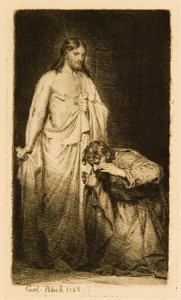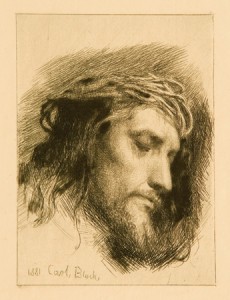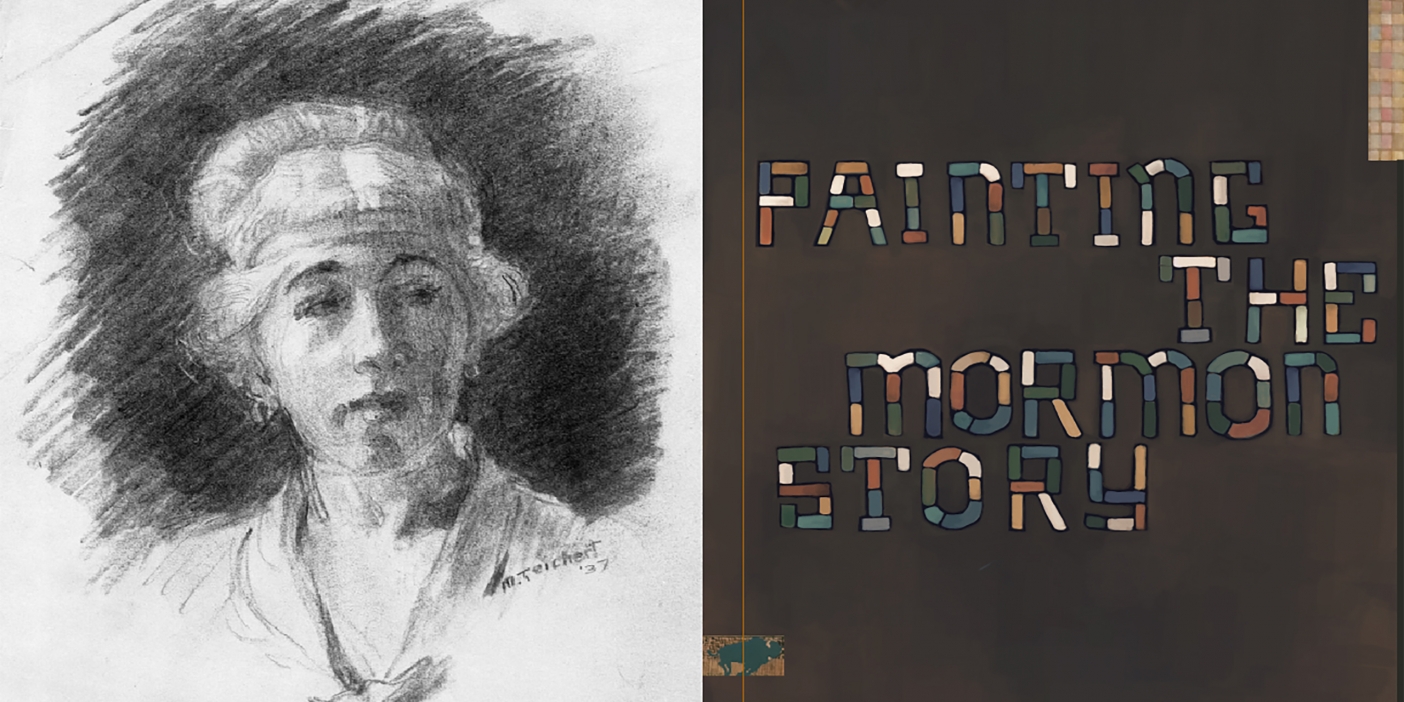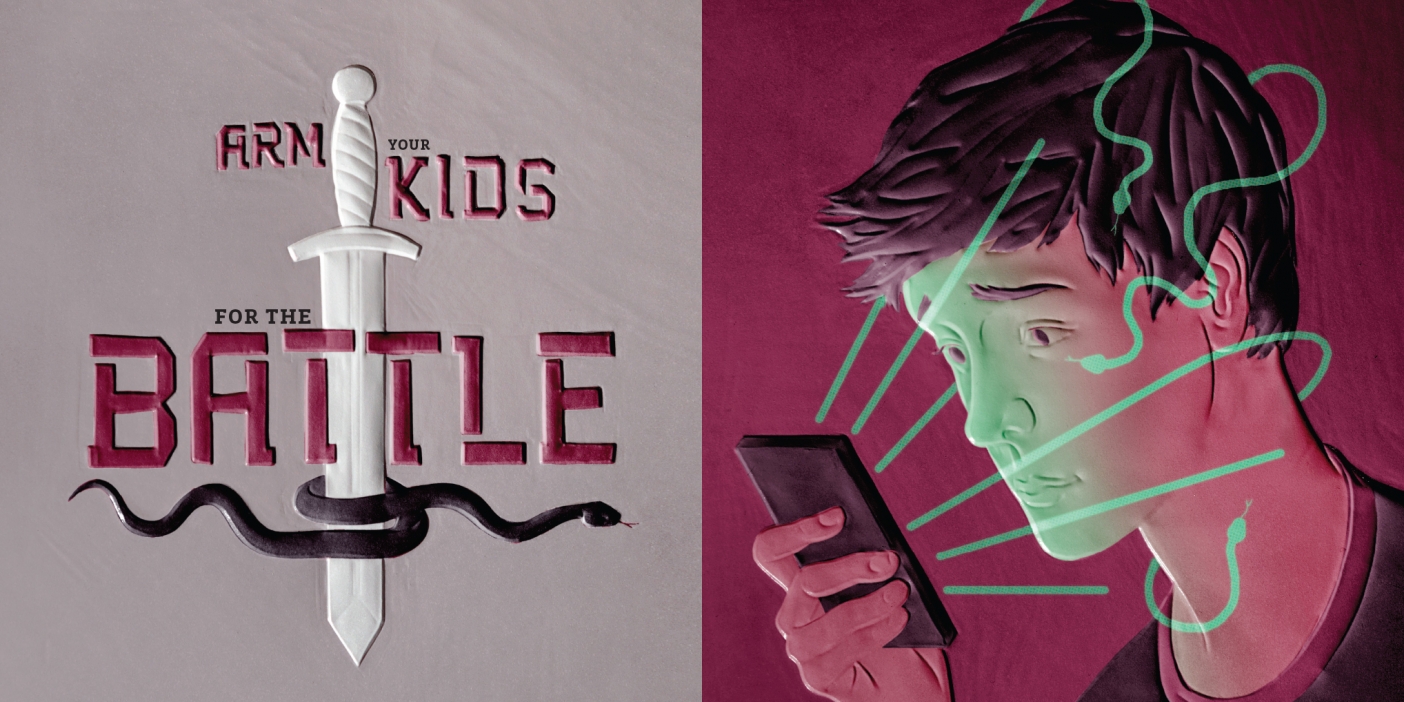Contact with the emblems of Christ’s suffering should shock us, humble us, and evoke in us a deep sense of gratitude.
Elder Henry B. Eyring of the Quorum of the Twelve Apostles once said that he has learned from President Hinckley that we must do better at getting the gospel down into our own hearts and the hearts of those we love and serve. We must constantly ask ourselves how to meet that challenge. I offer a suggestion born of my experience as president of a BYU stake.
Years ago Elder Boyd K. Packer gave a general conference address titled “The Mediator.” In that address Elder Packer said:
[The Atonement of Christ] is the very root of Christian doctrine. You may know much about the gospel as it branches out from there, but if you only know the branches and those branches do not touch that root, if they have been cut free from that truth, there will be no life nor substance nor redemption in them. [“The Mediator,” Ensign, May 1977, p. 56]
I will confess to you that I have participated in—indeed, I have taught—many lessons that, although interesting and motivational, according to Elder Packer’s guide had “no life nor substance nor redemption in them” because they weren’t directly linked to the Atonement of Christ. That’s a serious criticism of much of what we do, and I believe it’s on the mark. I believe that one way—the best way, and possibly the only way—to meet President Hinckley’s challenge to do better at getting the gospel down into our hearts and the hearts of those we love and serve is to focus all we do on the Atonement of Christ. And so, as a newly called stake presidency, we tried to do just that.
We laid down a rule that every sacrament meeting talk and every lesson in Sunday School, Relief Society, and priesthood meetings must be related to the Atonement of Christ in a direct and express way. Our goal was to have all of our meetings filled with “life [and] substance [and] redemption” by having them connected to “the very root of Christian doctrine”: the Atonement of Christ. We told the bishops that if they wanted a sacrament meeting about the principles of emergency preparedness—important principles, to be sure—that meeting would be about “Emergency Preparedness and the Atonement of Christ.” If you cannot figure out the link between the topic you are to teach and the Atonement of Christ, you have either not thought about it enough or you shouldn’t be talking about it at church. In our limited time in church, we must be talking about the Atonement of Christ.
This is what they did in the church in Alma’s day, the first church described in detail in the scriptures. They were given a mission similar to ours: prepare a people for the coming of the Risen Lord. Their experiences have special meaning to us as we try to fulfill our latter-day responsibilities. Note how the Book of Mormon describes their teaching:
And he commanded them that they should teach nothing save it were the things which he had taught, and which had been spoken by the mouth of the holy prophets.
Yea, even he commanded them that they should preach nothing save it were repentance and faith on the Lord, who had redeemed his people. [Mosiah 18:19–20]
They taught only from the scriptures and the words of the prophets, and they taught only two principles that are inextricably intertwined: “repentance,” that we have the constant need to improve; and “faith on the Lord, who had redeemed his people.” This was not faith in general—and not even faith in Christ as Friend, Good Shepherd, Prince of Peace, or any one of a number of important roles he plays—but faith in a very particular aspect of Christ’s mission: faith in his ability to redeem us, to improve us. He did that through his atoning sacrifice.
Now, linking every principle taught in our meetings to the Atonement in a direct and express way isn’t hard to do in sacrament meeting, because the bishopric can pick the topics. And it isn’t hard to do when the study guide lesson is on the Atonement or repentance. But what do you do when the study guide lesson is on tithing or visiting teaching or the value of education?
We made it clear that we expected the teachers to teach the approved curriculum. But it isn’t always obvious how the assigned material relates to the Atonement. To address that challenge, we had two suggestions.
First, we urged teachers to find examples of the principles being taught from the life of Christ. When we are talking about his life and using the words he said, we are remembering him, and a power comes into our teaching that is otherwise not present.
Second, we encouraged teachers to see either how the principle taught was part of Heavenly Father’s effort to draw us closer to him through Christ (the vertical pull of the Atonement) or how the principle could draw us closer to our fellow humans through Christ (the horizontal pull of the Atonement).
People got excited about this approach. It seemed right, so we pressed forward.
Why did it feel right? Because when we are speaking of what the Savior has done for us, we are at the core of the meaning of life, we are connected to “the very root of Christian doctrine,” and we are doing what Christ and his prophets have asked us to do.
Joseph Smith said:
The fundamental principles of our religion are the testimony of the Apostles and Prophets, concerning Jesus Christ, that He died, was buried, and rose again the third day, and ascended into heaven; and all other things which pertain to our religion are only appendages to it. [Teachings of the Prophet Joseph Smith, sel. Joseph Fielding Smith (Salt Lake City: Deseret Book, 1976) p. 121]
In the temple-recommend interview, we are asked, “Do you have a testimony of the Atonement of Christ and of his role as Savior and Redeemer?” In my experience as a bishop and a stake president, I can happily report that I have never had anyone answer that question other than yes; yet I have long had a concern that we don’t fully appreciate that question. I think it significant that of the many roles of Christ, we are asked about only two: his role as Savior and his role as Redeemer. There must be something about these roles that is particularly important to the temple—a place where he binds us to himself through covenants.
Like all stake presidents, I worried about the members of the stake. I worried about the things one might expect a priesthood leader of single adults to worry about, but I also worried about whether the members of the stake had “a testimony of the Atonement of Christ and of his role as Savior and Redeemer.” I had the sense that most of them loved Christ—no small thing—but I worried that not enough of them knew him as their Savior (one who had saved them) or their Redeemer (one who had bought them). While thinking about this one day, I was reading my favorite chapter in the Book of Mormon—3 Nephi 11—and I noticed some things I never had before.
The people in these chapters were the righteous remnant, those who had heeded the warnings of the prophets. They were prepared to meet the Lord. The story of that encounter is dramatic and moving and has profound implications for each of us as we prepare for Christ’s return.
 “And it came to pass [that] they cast their eyes up again towards heaven; and behold, they saw a Man descending out of heaven; and he was clothed in a white robe; and he came down and stood in the midst of them; and the eyes of the whole multitude were turned upon him, and they durst not open their mouths, even one to another, and wist not what it meant, for they thought it was an angel that had appeared unto them.” [3 Ne. 11:8]
“And it came to pass [that] they cast their eyes up again towards heaven; and behold, they saw a Man descending out of heaven; and he was clothed in a white robe; and he came down and stood in the midst of them; and the eyes of the whole multitude were turned upon him, and they durst not open their mouths, even one to another, and wist not what it meant, for they thought it was an angel that had appeared unto them.” [3 Ne. 11:8]
They were in awe and a little confused. The Savior’s first act of communication was “stretch[ing] forth his hand,” showing the symbol and evidence of his sacrifice. Those who were nearby couldn’t help but notice the wound in his hand. He was not timid about that wound. He wanted it to be seen.
After introducing himself as the prophesied Messiah and Creator of the universe, the next thing he wanted to tell them about was his Atonement:
I have drunk out of that bitter cup which the Father hath given me, and have glorified the Father in taking upon me the sins of the world, in the which I have suffered the will of the Father in all things from the beginning. [3 Ne. 11:11]
That was his message. He is the Anointed One of whom the prophets had testified. He is the Creator. He suffered for us.
Notice the response:
And it came to pass that when Jesus had spoken these words the whole multitude fell to the earth; for they remembered that it had been prophesied among them that Christ should show himself unto them after his ascension into heaven. [3 Ne. 11:12]
What followed is, to me, the most sacred part of this experience. Jesus commanded them to come forward one by one and do something difficult:
Arise and come forth unto me, that ye may thrust your hands into my side, and also that ye may feel the prints of the nails in my hands and in my feet, that ye may know that I am the God of Israel, and the God of the whole earth, and have been slain for the sins of the world. [3 Ne. 11:14]
There is a gruesome quality to this command. In our culture we hide scars, we don’t display them, and we certainly don’t ask others to feel them. But Christ wanted these people to have physical contact with these emblems of his suffering.
And it came to pass that the multitude went forth, and thrust their hands into his side, and did feel the prints of the nails in his hands and in his feet; and this they did do, going forth one by one until they had all gone forth [all 2,500 of them]. [3 Ne. 11:15]
Some have suggested that this sacred experience took several hours.
Now please note carefully what happened next:
And when they had all gone forth and had witnessed for themselves, they did cry out with one accord, saying:
Hosanna! Blessed be the name of the Most High God! And they did fall down at the feet of Jesus, and did worship him. [3 Ne. 11:16–17]
Notice what just happened. The second time these people fell at Jesus’ feet, they “did worship him.” That didn’t happen the first time. The first time they may have fallen to the ground for any number of reasons: fear, awe, peer pressure. I don’t know. But the second time they fell to worship him. Why the different reaction from the first time? The second time they cried out in unison, “Hosanna!” which means, “Save us, now!” Why were these people, the righteous remnant, crying out to Christ for salvation now?
Let me suggest a possible answer. Although they had been obedient, perhaps they had not yet come to know him as their Savior because they had not yet felt the need to be saved. They had led lives filled with good works. They knew Jesus as God, as Exemplar, maybe even as Friend. But maybe they didn’t yet know him as Savior. Their prayer wasn’t, “Thank you for having saved us in the past and reminding us of that by your presence today.” No, the prayer was a current plea: “Hosanna!” or “Save us, now!” That suggests to me that they were just then coming to know him as Savior.
What had done that? What had turned them from good, obedient people to good, obedient people who now knew Jesus Christ as Savior? What had caused them to fall down at his feet to worship him? It was physical contact with the emblems of his suffering.
 That was what our stake needed so they could come to know Christ as their Savior and Redeemer: physical contact with the emblems of his suffering. But how do we make that happen? Then it occurred to me: We have that experience every Sunday when we partake of the sacrament of the Lord’s Supper. We eat the broken bread, a token of his slain body. We drink the water, a symbol of his spilt blood. These are striking symbols intended to shock us, to evoke in us a deep sense of gratitude.
That was what our stake needed so they could come to know Christ as their Savior and Redeemer: physical contact with the emblems of his suffering. But how do we make that happen? Then it occurred to me: We have that experience every Sunday when we partake of the sacrament of the Lord’s Supper. We eat the broken bread, a token of his slain body. We drink the water, a symbol of his spilt blood. These are striking symbols intended to shock us, to evoke in us a deep sense of gratitude.
Remember the transforming effect that experience had on the people in the Book of Mormon? They were now prepared to be organized anew into a church community, to hear and put into practice the teachings of the Sermon on the Mount, to learn how to serve those who were powerless: the sick, the disabled, the children. This group transformed their society from one that had been divided by race and class and opportunity into a society in which
they had all things common among them; . . . there were not rich and poor, bond and free, but they were all made free, and partakers of the heavenly gift . . .
. . . because of the love of God which did dwell in the hearts of the people. [4 Ne. 1:3, 15]
It began with a group of people who came to know Christ as their Savior because of the transforming experience of having physical contact with the emblems of his suffering. And we do that every week! I believe that our meaningful participation in the sacrament of the Lord’s Supper will elicit the same response in us. We will cry out to Christ in our hearts, “Save us, now!” and we will fall down at his feet to worship him.
As Elder Jeffrey R. Holland (BS ’65) has taught:
It is the wounded Christ who is the captain of our soul—he who yet bears the scars of sacrifice, the lesions of love and humility and forgiveness.
Those wounds are what he invites young and old, then and now, to step forward and see and feel. . . . Then we remember with Isaiah that it was for each of us that our Master was “despised and rejected . . . ; a man of sorrows, and acquainted with grief” (Isa. 53:3). All this we could remember when we are invited by a kneeling young priest to remember Christ always. [“This Do in Remembrance of Me,” Ensign, November 1995, p. 69; emphasis in original]
Brothers and sisters, we must come to know in great detail and with insight and feeling the events that make up the Atonement of Christ. We find in the Restoration of the gospel much help. In the Book of Mormon and the revelations given to the Prophet Joseph Smith, we have knowledge about the Atonement of Christ that should be our gift to the world. We know from the New Testament account that an important element of his motivation in those excruciating hours was his love for Heavenly Father. From Alma, however, we learn that he was also driven by his desire to help you and me:
And he will take upon him death, that he may loose the bands of death which bind his people; and he will take upon him their infirmities, that his bowels may be filled with mercy, according to the flesh, that he may know according to the flesh how to succor his people according to their infirmities. [Alma 7:12]
In the last revelation Joseph Smith received before he was permitted to organize Christ’s Church on the Earth—in what was the capstone of Joseph Smith’s preparation to be an Apostle of the Lord Jesus Christ—the Lord gave the only first-person detailed account of the suffering he endured so that we would not need to suffer the full effects of our disobedience:
For behold, I, God, have suffered these things for all, that they might not suffer if they would repent; . . .
Which suffering caused myself, even God, the greatest of all, to tremble because of pain, and to bleed at every pore, and to suffer both body and spirit—and would that I might not drink the bitter cup, and shrink— [D&C 19:16, 18]
Now what kind of a God do we worship? A God who wants us to know that his love for us gave him the strength to suffer for us. Knowing this ought to be enough to move us to submit our lives to him in obedience and gratitude.
Some time ago I overheard a spirited discussion between two good people about a work of art that contained a realistic and disturbing portrayal of Christ’s suffering. One of them objected to the work and said, “You know, I don’t want to have to think about how much Christ has suffered.” I thought that was an odd thing to say, because I don’t believe that any of us has the license to avoid thinking about what Christ suffered. In fact, as I read the scriptures, that is among the things we are commanded to think about constantly.
Moroni, anxious to give his readers motivation to “come unto Christ” (Moro. 10:30, 32), shared with us a personal letter from his father. It must have had a great impact on him, and now he hoped that it would have a great impact on us.
My son, be faithful in Christ; and may not the things which I have written grieve thee, to weigh thee down unto death; but may Christ lift thee up, and may his sufferings and death, and the showing his body unto our fathers, and his mercy and long-suffering, and the hope of his glory and of eternal life, rest in your mind forever. [Moro. 9:25]
Among the things that are to “rest in [our] mind forever” are the “sufferings and death” of Christ. We should not avoid thinking about the price he paid to win our souls.
In a recent sacrament meeting I followed along as the speaker read a familiar passage of scripture. You know it: “Remember the worth of souls is great in the sight of God” (D&C 18:10). I cannot recall where the speaker then went with his remarks. Wherever it was, I did not follow, because my mind seized hold on an idea in the next verse that I had never noticed before. To prove the great worth of our souls, the Lord told us:
For, behold, the Lord your Redeemer suffered death in the flesh; wherefore he suffered the pain of all men, that all men might repent and come unto him. [D&C 18:11; emphasis added]
His suffering proves his love, but it does more. It is the means he uses to get us to “repent and come unto him.” When we come to have some sense of what Christ has done for us—and, in particular, what he has suffered for us—our natural reaction as children of God is to want to show our gratitude and love by giving our lives to him, by obeying him. This verse is, in my opinion, the most succinct and profound description—from the Lord himself—of how to get the gospel down into the hearts of you and me and those we serve.
The best way—the only way—to persuade people to repent and come unto Christ is to get them—to get us—to think about what he has done for us and especially about what he has suffered for us. That is how Christ does it. This is an insight from the Restoration that we can and must use in our homes, our meetings, and all of our teachings.
The Lord’s current prophet, Gordon B. Hinckley, recently told us:
No member of this Church must ever forget the terrible price paid by our Redeemer, who gave His life that all men might live—the agony of Gethsemane, the bitter mockery of His trial, the vicious crown of thorns tearing at His flesh, the blood cry of the mob before Pilate, the lonely burden of His heavy walk along the way to Calvary, the terrifying pain as great nails pierced His hands and feet. . . .
We cannot forget that. We must never forget it, for here our Savior, our Redeemer, the Son of God, gave Himself, a vicarious sacrifice for each of us. [“The Symbol of Our Faith,” Ensign, April 2005, p. 4]
To those words of a prophet of God and an Apostle of Jesus Christ, I add my witness. This is “the very root of Christian doctrine.” May we always remember him and the price he paid to win our souls.
Thomas B. Griffith is a federal judge on the U.S. Court of Appeals for the District of Columbia Circuit and is a former BYU general counsel. This article is adapted from a BYU devotional address he gave March 14, 2006.










